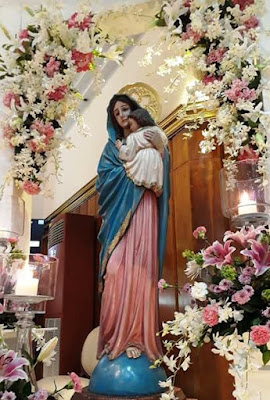The Clandestine Our Lady of Beautiful Love of Parañaque City
 |
| Our Lady of Beautiful Love of Parañaque City |
Aside from those aforementioned shrines and images, there is a lot more to see and to be visited in South Metro Manila, one of them is the Parish dedicated to Our Lady, in a very unique title as Our Lady of Beautiful Love - the only church dedicated to this Marian title in the Philippines.
The image
The image of Our Lady of Beautiful Love is a de tallado image of the Blessed Virgin Mary carrying the Infant Jesus in her arms. The image presents the Virgin in a very tender gesture where she holds the sleeping Child near to her, resting in her arms. The Virgin wears a pink robe and a long blue veil that also doubles as a mantle to the Child Jesus. This image was pattered to a renowned painting "Madonina" or more popularly known as "Madonna of the Streets" by Roberto Ferruzzi.
 |
| "Madonnina" by Roberto Ferruzzi |
The simple yet tender image of Our Lady of Beautiful Love of Merville, Parañaque City was based from the famed painting "Madonnina" or more popularly known as "Madonna of the Streets" by Roberto Ferruzzi. The original painting made its first appearance at an art exhibition in Venice in 1897.
The artist called his painting "Madonnina" (Little Madonna) because he took a peasant girl from the region of Padua to pose for this painting. According to credible sources, the girl was one Angelina Cian who eventually emigrated to San Francisco with her husband Antonio Boro where they raised a family of ten children. When Ferruzzi first spotted the girl, she was about eleven years old and caring for her baby brother. The artist decided to paint a portrait of the two. He never intended the painting to be one of the Virgin Mary. But since the girl looked like a little Madonna, he called the painting "Madonnina"
The painting eventually gained world fame and came to be known as "The Madonna of the Streets". This new name reflects the spirit and flavor of the art work. The focal point is the girl's face with its pleading and expressive countenance. It is wrapped in a gold colored headdress, the only warm color of the whole painting. The blues and greys and dirty whites of mother's and child's dress and of the whole backdrop suggest hardship, toil and poverty. There is a contrast between Mother and child: while the child is safely cuddled and asleep in the arms of his mother, Our Lady appears to be standing on somebody's doorstep begging for shelter and food.
 |
| Our Lady of Beautiful Love of Parañaque City |
Although the original has disappeared, it has not hindered the great popularity and usage of the image. Copies of the original are frequently featured on holy cards, portraits, greeting cards, statues, mosaics, medals, etc..
The devotion in Parañaque
The origin of the devotion to Our Lady of Beautiful Love began in 1965 where the Merville Park Homeowners Association in Parañaque built a chapel for the area to cater the spitiual needs of the faithful in Merville in a vacant property of the Gonzales family. The Parish was formally established by the late Archbishop of Manila, +Rufino Cardinal Santos on April 20, 1969.
 |
| Our Lady of Beautiful Love Parish, Merville, Parañaque City |
The feast of Our Lady of Beautiful Love is celebrated every May 12th. The fiesta became a local affair with families in Merville coming together to celebrate their village's patronal feast.
As we end this blogpost dedicated to Our Lady of Beautiful Love, here is the prayer that her devotees recited by her devotees which we can also adopt:
Prayer to Our Lady of Beautiful Love
Mary, our Mother of Beautiful Love, fountain of all graces, , in the hours of loneliness weariness and trials; in doubts, perplexities and temptations; in joys and sorrows, in falls and shortcomings; above all, at the hour of death, so that we may share in the resurrection of your Son, Our Lord Jesus Christ.
(Make your Request)
We bless and thank the Lord God for giving you to us. In His mercy and goodness, we claim our prayers are already answered. Amen.
References:
"Madonnina del Ferruzzi" (in Italian). luvigliano.it, Retrieved on August 30, 2019.
O'Marie, Carole Anne, "Her Mother was a Madonna", Catholic Digest, 1986.
"Our Lady of Beautiful Love Parish History", Retrieved from https://olblparish.wordpress.com/the-olbl-parish/history/ on August 30, 2019.
Credits to the owners of the photographs utilized to this blogpost.
+AM+DG+





Comments
Post a Comment